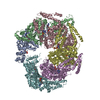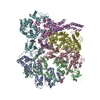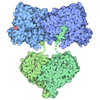+ Open data
Open data
- Basic information
Basic information
| Entry | Database: PDB / ID: 5kne | |||||||||||||||
|---|---|---|---|---|---|---|---|---|---|---|---|---|---|---|---|---|
| Title | CryoEM Reconstruction of Hsp104 Hexamer | |||||||||||||||
 Components Components | Heat shock protein 104 Heat shock response Heat shock response | |||||||||||||||
 Keywords Keywords |  CHAPERONE / CHAPERONE /  Hsp104 / Hsp104 /  AAA+ protein AAA+ protein | |||||||||||||||
| Function / homology |  Function and homology information Function and homology informationtrehalose metabolism in response to heat stress / TRC complex / cellular heat acclimation /  protein folding in endoplasmic reticulum / protein folding in endoplasmic reticulum /  post-translational protein targeting to endoplasmic reticulum membrane / stress granule disassembly / chaperone cofactor-dependent protein refolding / protein unfolding / nuclear periphery / post-translational protein targeting to endoplasmic reticulum membrane / stress granule disassembly / chaperone cofactor-dependent protein refolding / protein unfolding / nuclear periphery /  ADP binding ...trehalose metabolism in response to heat stress / TRC complex / cellular heat acclimation / ADP binding ...trehalose metabolism in response to heat stress / TRC complex / cellular heat acclimation /  protein folding in endoplasmic reticulum / protein folding in endoplasmic reticulum /  post-translational protein targeting to endoplasmic reticulum membrane / stress granule disassembly / chaperone cofactor-dependent protein refolding / protein unfolding / nuclear periphery / post-translational protein targeting to endoplasmic reticulum membrane / stress granule disassembly / chaperone cofactor-dependent protein refolding / protein unfolding / nuclear periphery /  ADP binding / unfolded protein binding / protein-folding chaperone binding / protein refolding / ADP binding / unfolded protein binding / protein-folding chaperone binding / protein refolding /  ATP hydrolysis activity / ATP hydrolysis activity /  ATP binding / identical protein binding / ATP binding / identical protein binding /  nucleus / nucleus /  cytosol / cytosol /  cytoplasm cytoplasmSimilarity search - Function | |||||||||||||||
| Biological species |   Saccharomyces cerevisiae (brewer's yeast) Saccharomyces cerevisiae (brewer's yeast) | |||||||||||||||
| Method |  ELECTRON MICROSCOPY / ELECTRON MICROSCOPY /  single particle reconstruction / single particle reconstruction /  cryo EM / Resolution: 5.64 Å cryo EM / Resolution: 5.64 Å | |||||||||||||||
 Authors Authors | Yokom, A.L. / Gates, S.N. / Jackrel, M.E. / Mack, K.L. / Su, M. / Shorter, J. / Southworth, D.R. | |||||||||||||||
| Funding support |  United States, 4items United States, 4items
| |||||||||||||||
 Citation Citation |  Journal: Nat Struct Mol Biol / Year: 2016 Journal: Nat Struct Mol Biol / Year: 2016Title: Spiral architecture of the Hsp104 disaggregase reveals the basis for polypeptide translocation. Authors: Adam L Yokom / Stephanie N Gates / Meredith E Jackrel / Korrie L Mack / Min Su / James Shorter / Daniel R Southworth /  Abstract: Hsp104, a conserved AAA+ protein disaggregase, promotes survival during cellular stress. Hsp104 remodels amyloids, thereby supporting prion propagation, and disassembles toxic oligomers associated ...Hsp104, a conserved AAA+ protein disaggregase, promotes survival during cellular stress. Hsp104 remodels amyloids, thereby supporting prion propagation, and disassembles toxic oligomers associated with neurodegenerative diseases. However, a definitive structural mechanism for its disaggregase activity has remained elusive. We determined the cryo-EM structure of wild-type Saccharomyces cerevisiae Hsp104 in the ATP state, revealing a near-helical hexamer architecture that coordinates the mechanical power of the 12 AAA+ domains for disaggregation. An unprecedented heteromeric AAA+ interaction defines an asymmetric seam in an apparent catalytic arrangement that aligns the domains in a two-turn spiral. N-terminal domains form a broad channel entrance for substrate engagement and Hsp70 interaction. Middle-domain helices bridge adjacent protomers across the nucleotide pocket, thus explaining roles in ATP hydrolysis and protein disaggregation. Remarkably, substrate-binding pore loops line the channel in a spiral arrangement optimized for substrate transfer across the AAA+ domains, thereby establishing a continuous path for polypeptide translocation. | |||||||||||||||
| History |
|
- Structure visualization
Structure visualization
| Movie |
 Movie viewer Movie viewer |
|---|---|
| Structure viewer | Molecule:  Molmil Molmil Jmol/JSmol Jmol/JSmol |
- Downloads & links
Downloads & links
- Download
Download
| PDBx/mmCIF format |  5kne.cif.gz 5kne.cif.gz | 531.9 KB | Display |  PDBx/mmCIF format PDBx/mmCIF format |
|---|---|---|---|---|
| PDB format |  pdb5kne.ent.gz pdb5kne.ent.gz | 322.4 KB | Display |  PDB format PDB format |
| PDBx/mmJSON format |  5kne.json.gz 5kne.json.gz | Tree view |  PDBx/mmJSON format PDBx/mmJSON format | |
| Others |  Other downloads Other downloads |
-Validation report
| Arichive directory |  https://data.pdbj.org/pub/pdb/validation_reports/kn/5kne https://data.pdbj.org/pub/pdb/validation_reports/kn/5kne ftp://data.pdbj.org/pub/pdb/validation_reports/kn/5kne ftp://data.pdbj.org/pub/pdb/validation_reports/kn/5kne | HTTPS FTP |
|---|
-Related structure data
| Related structure data |  8267MC M: map data used to model this data C: citing same article ( |
|---|---|
| Similar structure data |
- Links
Links
- Assembly
Assembly
| Deposited unit | 
|
|---|---|
| 1 |
|
- Components
Components
| #1: Protein |  Heat shock response / Protein aggregation-remodeling factor HSP104 Heat shock response / Protein aggregation-remodeling factor HSP104Mass: 95967.398 Da / Num. of mol.: 6 Source method: isolated from a genetically manipulated source Source: (gene. exp.)   Saccharomyces cerevisiae (brewer's yeast) Saccharomyces cerevisiae (brewer's yeast)Gene: HSP104, YLL026W, L0948 / Production host:   Escherichia coli (E. coli) / References: UniProt: P31539 Escherichia coli (E. coli) / References: UniProt: P31539#2: Chemical | ChemComp-ANP / |
|---|
-Experimental details
-Experiment
| Experiment | Method:  ELECTRON MICROSCOPY ELECTRON MICROSCOPY |
|---|---|
| EM experiment | Aggregation state: PARTICLE / 3D reconstruction method:  single particle reconstruction single particle reconstruction |
- Sample preparation
Sample preparation
| Component | Name: Hexamer Complex of Hsp104 / Type: COMPLEX / Entity ID: #1 / Source: RECOMBINANT |
|---|---|
| Source (natural) | Organism:   Saccharomyces cerevisiae (brewer's yeast) Saccharomyces cerevisiae (brewer's yeast) |
| Source (recombinant) | Organism:   Escherichia coli (E. coli) / Plasmid Escherichia coli (E. coli) / Plasmid : pNOTAG : pNOTAG |
| Buffer solution | pH: 7.5 |
| Specimen | Conc.: 0.7 mg/ml / Embedding applied: NO / Shadowing applied: NO / Staining applied : NO / Vitrification applied : NO / Vitrification applied : YES / Details: Clean protein sample incubated with AMP-PNP : YES / Details: Clean protein sample incubated with AMP-PNP |
| Specimen support | Grid material: COPPER / Grid mesh size: 200 divisions/in. / Grid type: C-flat |
Vitrification | Instrument: FEI VITROBOT MARK IV / Cryogen name: ETHANE / Details: Plunged into liquid ethane (FEI VITROBOT MARK IV) |
- Electron microscopy imaging
Electron microscopy imaging
| Experimental equipment |  Model: Titan Krios / Image courtesy: FEI Company |
|---|---|
| Microscopy | Model: FEI TITAN KRIOS |
| Electron gun | Electron source : :  FIELD EMISSION GUN / Accelerating voltage: 300 kV / Illumination mode: FLOOD BEAM FIELD EMISSION GUN / Accelerating voltage: 300 kV / Illumination mode: FLOOD BEAM |
| Electron lens | Mode: BRIGHT FIELD Bright-field microscopy / Cs Bright-field microscopy / Cs : 2.7 mm : 2.7 mm |
| Specimen holder | Cryogen: NITROGEN / Specimen holder model: FEI TITAN KRIOS AUTOGRID HOLDER |
| Image recording | Average exposure time: 0.2 sec. / Electron dose: 1.6 e/Å2 / Detector mode: COUNTING / Film or detector model: GATAN K2 SUMMIT (4k x 4k) / Num. of grids imaged: 2 / Num. of real images: 3661 Details: Movies contained 38 of 40 frames from an 8 sec exposure (200 milliseconds per frame). |
| Image scans | Movie frames/image: 40 / Used frames/image: 2-40 |
- Processing
Processing
| EM software |
| ||||||||||||
|---|---|---|---|---|---|---|---|---|---|---|---|---|---|
CTF correction | Type: PHASE FLIPPING AND AMPLITUDE CORRECTION | ||||||||||||
| Particle selection | Num. of particles selected: 240005 Details: Particles were selected using automated picking within the Appion package. | ||||||||||||
3D reconstruction | Resolution: 5.64 Å / Resolution method: FSC 0.143 CUT-OFF / Num. of particles: 172043 / Num. of class averages: 1 / Symmetry type: POINT | ||||||||||||
| Atomic model building | Details: Backbone atoms fit into reconstruction density. |
 Movie
Movie Controller
Controller










 PDBj
PDBj















